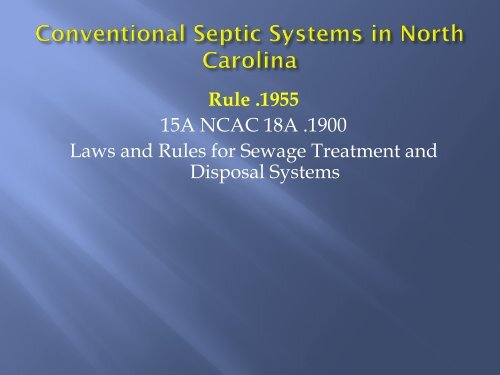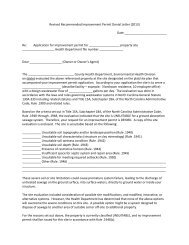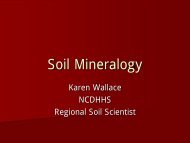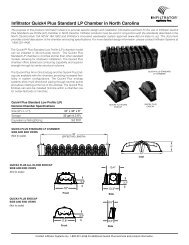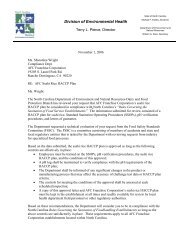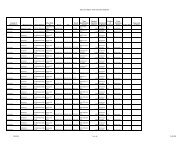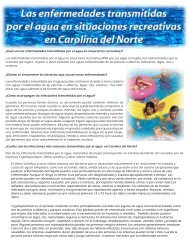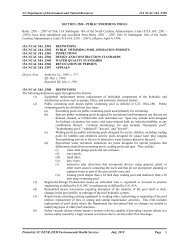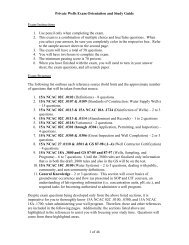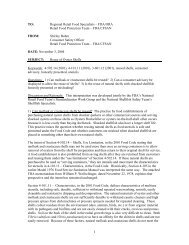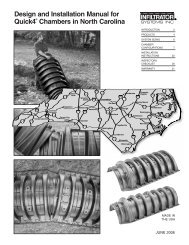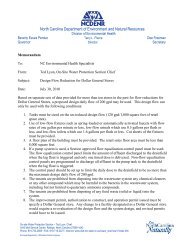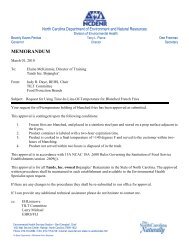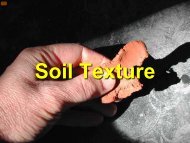Components of Conventional System
Components of Conventional System
Components of Conventional System
- No tags were found...
You also want an ePaper? Increase the reach of your titles
YUMPU automatically turns print PDFs into web optimized ePapers that Google loves.
Rule .195515A NCAC 18A .1900Laws and Rules for Sewage Treatment andDisposal <strong>System</strong>s
1.Collection Lines – carries sewage from facilityto septic tank2.Septic Tank - separates, stores, and begins totreat solid wastes3.Distribution <strong>System</strong> - carries effluent from thetank to the drain field4.Drain Field or Nitrification Field or SoilAbsorption <strong>System</strong> - generally a series <strong>of</strong>perforated drainpipes in aggregate buried in theground
Purpose: To convey raw (untreated) sewage fromthe house to the septic tankRequirements: Based on ASTM standards inaccordance with NC Plumbing Code
Requirements:• Scour Velocity2 ft/sec (half full pipe)1 ft/sec (full pipe)Typically 1/8” per foot <strong>of</strong> fall for raw sewage• Cleanouts every 50’ and for bends >45 degrees (4”sewer lines)
Function as a “black box”???InOutSeptic Tank
Historical Perspective:“A mysterious contrivance consisting <strong>of</strong> a vaulthermetically closed by a hydraulic seal…itrapidly transforms all the excrementitiousmatter it receives into a homogeneous fluid…”Louis Mouras, 1881
Factors influencing biological activity:• Composition <strong>of</strong> wastewater• Flow quantity and variability• Temperature
Purpose:• Primary Treatment: Solids removal as a function <strong>of</strong>quiescence and retention time• Secondary Treatment: Limited anaerobicdecomposition• Storage <strong>of</strong> accumulated solids
2 compartment tank (required in NC)InfluentAccessVentFreeboardAccessEffluentLiquidDepthSludgeScumBaffleWallInvertSanitary teew/ filter
What are septic tank effluent filters?• Mechanical filters• Constructed <strong>of</strong> corrosion-pro<strong>of</strong> material• Replaces the outlet “T” <strong>of</strong> the septic tankWhy use effluent filters?• Improve quality <strong>of</strong> effluent discharged fromseptic tanks• Extend life <strong>of</strong> soil absorption system• Required by North Carolina General Statutes
Purpose:• Conveys effluent from septic tank to distribution device (ifapplicable) and to drainlinesSpecifications:–3” or 4” PVC (poly vinyl chloride), PE(polyethylene) or ABS (acrylonitrilebutadiene-styrene)pipe–May substitute corrugated PE pipe(w/proper bedding)–Minimum fall 1/8” per foot
Purpose:• To convey an equal portion <strong>of</strong> effluent from thesupply line to each individual drainlineTypes: D-Box or Divider TeeEqual distribution requires equal lengthtrenches!
D-BoxFlow DividerLeveling Devices
Plan View:DrainlinesD-BoxSeptic Tank
Purpose:• To fully utilize each individual drainline prior todistributing effluent to remaining line(s)Types: Drop Box or Step DownSerial distribution does not require equal lengthtrenches!
Plan View: StepdownsSeptic TankDrainlinesStepdownStepdown
Drop BoxSerial distribution does not require equal lengthtrenches!
Plan View: Drop BoxesSeptic TankDrainlinesDrop Boxes
Septic TankDrainlinesD-BoxSeptic TankDrainlinesStepdownStepdown
Specifications:• Leak pro<strong>of</strong>• 2’ separation to septic tank and drainline(s)• As approved by LHD• Must be demonstrated by installer to perform asdesigned
Purpose:• Provide storage <strong>of</strong> wastewater until treatment anddisposal can occur• Provide surface area at the soil interface fortreatment and disposal
- Trenches level in all directions (maximum fall <strong>of</strong> 1/4” per 10’).- Trenches shall follow ground contour if slope > 2% OR- When necessary to maintain trench bottom depth
Crushed Stone Sizes #3, #4, #5, #57, #6Specified by ASTM Standards
Tire Chips
Corrugated, perforated PE tubing4” or 6” diameter3 rows <strong>of</strong> 1/2” to 3/4” holeslongitudinally ~4” on centersOrientation<strong>of</strong> Holes(C/S)
Purpose:• To absorb andphysically filtercomponents from theeffluent as well asfacilitate chemical andbiological remediation<strong>of</strong> organic andpathogenic materials.
Effluent Distribution
Single cells:- grazers- particle feeders- scavengers
Roundworms –free livingAlso common inactivated sludge andseptic tanks.Feed on chunks <strong>of</strong>bacterial floc.Aerate soil
Biomat
A relativelydense sewagedigestingcommunity <strong>of</strong>organisms inthe immediatearea wherethe aggregatecomponent <strong>of</strong>the septicsystemcontacts thesoil
THE OBJECTIVE OF ALEACHING FIELD IS TOPROVIDE UNSATURATED FLOWOF EFFLUENT TO THEGROUNDWATERTHE OBJECTIVE OF ALEACHING FIELD IS TOPROVIDE UNSATURATED FLOWOF EFFLUENT TO THEGROUNDWATER
LTAR – Long Term Acceptance RateStated in gallons per ft² per day (gpd/ft²)The amount <strong>of</strong> effluent that can be applied tothe Nitrification field to achieve and maintainaerobic and unsaturated flow.
VirusesPutting viruses in perspective?If a sand grainenlarged, = ~ 94 feet high !That nematode = 180’+ long0.5 mm - was similarlyThe pore space between sand grains = 13feet wide !Reovirus 70-75nanometer (10 -9meter)Enlarged ~57,000timesYou would be 60 miles tall !
Early Roman Law(governing chamber pots)Dejecti Effusive ActA person shall be fined andpay damages to theinjured party for throwingor pouring “missiles <strong>of</strong>mirth” out an openwindow and hittingsomeone.Note: Law only appliedduring daylight hours.Questions?


